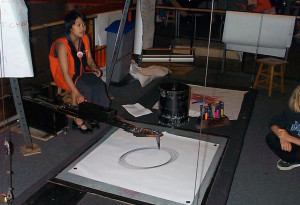

Exploratorium – San Francisco
Explained:
It’s structure is simple: a flat bed suspended from its corners by wire so that it can smoothly swing, and a single arm that firmly presses a marker on a sheet of paper (drawing as the bed oscillates).
Chosen:
The drawing machine at the Exploratorium was the coolest thing I had ever seen when I was a kid, but naturally the line was always too long for me to ever get to use it. All you have to do to create crazy algorithmic images was swing the table at a slant so it moved in a somewhat sinusoidal motion. Every so often (when a pattern got boring or ended) you could swap out the color and swing the table again layering different patterns with different colors.
Critiqued:
Although I think that the machine was perfect as it was, I think it could create more visually interesting designs. I think the system could easily incorporate more degrees of freedom that impact the drawn pattern as well as the quality of the stroke.
For instance:
- Limiting factor
- Possible solution to increase variability
- There is only one arm and that arm is in a fixed position
- Multiple simultaneously oscillating arms
- The arm that holds the pen creates a relatively uniform stroke
- The pressure could oscillate as well
- Once the bed has been put into motion, its path cannot be modified (only started or stopped)
- Add a nudge factor to alter the pattern mid draw
- Fixed cables supporting the table restrict the set of patterns that can be created
- The ability to adjust the bed’s center of gravity
Related:
While researching this machine, I stumbled upon the concept of a “Harmonograph” and what I assume is the precursor to the Exploratorium’s machine, the “Three-Pendulum Rotary Harmonograph Machine”
Also, This is pretty cool
Leave a Reply